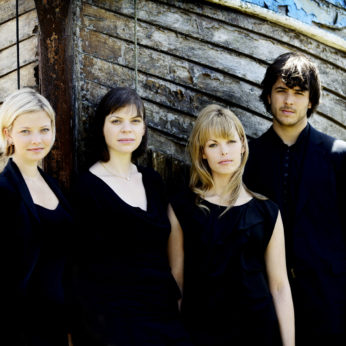Composer: Franz Schubert (b. 1797 - d. 1828)
Performance date: 04/07/2016
Venue: St. Brendan’s Church
Composition Year: 1824
Duration: 00:42:00
Recording Engineer: Richard McCullough, RTÉ lyric fm
Instrumentation: 2vn, va, vc
Instrumentation Category:String Quartet
Artists:
Chiaroscuro Quartet (Alina Ibragimova, Pablo Hernán Benedí [violins], Emilie Hörnlund [viola], Claire Thirion [cello]) -
[quartet]

This
performance of Death and the Maiden will
require some aural re-tuning. Chiaroscuro play at the lower classical pitch of
A430 as well as on gut strings with minimal vibrato. So we can expect a very
different view of a familiar masterpiece.
Schubert’s
D minor quartet is the cry of despair of a man under sentence of death, those
Romantic and melodramatic songs he set to music in another carefree world had
suddenly become real. Those remorseless galloping hooves as the hapless father
with his feverish and dying son in his arms hopelessly tries to escape the Erlkönig can now be heard by Schubert
himself. And the cold grip of Death as he takes the Maiden in his arms is an
ever-present fear. For him personally this is all brutally and disgustingly
present and the desperate composer can only try to cheat death by overcoming
him with music.
The
power of the writing is there from the opening challenge, as though Schubert is
daring us not to listen to what he has to say, and this challenge goes on to
meet its appalled climax in the coda of this opening movement. The first
thematic outburst is gradually softened, dynamically as well as harmonically
before the theme takes off in the frantic pursuit by the Erlkönig, interrupted only by the violent chords from the opening.
The gentler second theme is still haunted by the pursuing triplets before the
first theme forces its way back and builds to a whole series of violent
conclusions. After the exposition repeat, a massive chord cuts straight into
the development. This further unsettles us by combining both subjects at the
same time. The recapitulation follows without a break leading us to the appalled
coda with its great gasp of horror that evolves into one last pursuit hurtling
towards the violin’s desperate pleas for help.
The
cry for help is met by the strict formality of a theme with five variations and
a coda from whose self-imposed restriction there is no escape. The music is
taken from the piano accompaniment to the voice of Death in the song, constructing
in the process a new binary form theme in G minor.
The
consoling mood of the theme is harmonically constricted by Schubert’s sense of
horror at what is happening to him. The first three variations see a gradual
increase in time values; in the first the theme is given to the middle voices
with the cello’s pizzicato underpinning the first violin’s decorations, the
second has the theme in the viola while the third sees a unison and fortissimo
attack. The fourth variation bursts out with the galloping triplets, while the
fifth sees a slow crescendo to a dreadful climax that fades quietly into the
coda’s bell-like echoes of Death’s theme.
The
Scherzo reverts to the tough D minor mood of the first movement, which makes it
all the more surprising to find out that Schubert has borrowed the theme from
one of his hundreds of keyboard dances. The Trio is more soothing, in the
customary binary form but with the repeats varied.
The
presto finale returns to the nocturnal gallop of the opening movement, propelled
by an obsessive rhythmic figure of seemingly inexhaustible energy until
chillingly interrupted by another metamorphosis of the Death theme. In these
last extraordinary pages Schubert works out his dreaded vision of beauty and
horror galloping together endlessly through the night.
Copyright © 2025 West Cork Music. All rights reserved.
Designed and developed by Matrix Internet